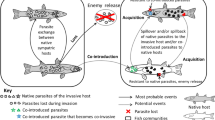Summary
A common assumption in mathematical models of parasitism is that the susceptibility to parasitism of an individual host increases both with host density and the degree of host spatial aggregation. To determine whether this assumption is correct in nature, we developed a factorial field experiment with the parasitic marine isopod Hemioniscus balani and its barnacle host Chthamalus dalli. Our factorial design enabled evaluation of the separate effects on parasitism of the two factors (host density and host spatial pattern) and also to assess the host density-spatial pattern interaction effect. Both host density and spatial aggregation were found to lead to increased parasitism, and the interaction effect was nonsignificant. These findings are the first experimental field demonstration that these processes occur in nature, as widely assumed in ecological theory.
Similar content being viewed by others
References
Anderson RM, May RM (1978) Regulation and stability of hostparasite population interactions. 1. Regulatory processes. J Anim Ecol 47:219–247
Beddington JR, Free CA, Lawton JH (1978) Modelling biological control: on the characteristics of successful natural enemies. Nature 273:513–519
Crisp DJ (1960) Factors influencing growth rate in Balanus balanoides. J Anim Ecol 29:95–115
Hassell MP (1978) The dynamics of Arthropod Predator-Prey Systems. Princeton University Press, Princeton
Hassell MP (1980) Some consequences of habitat heterogeneity for population dynamics. Oikos 35:150–160
Hassell MP, May RM (1973) Stability in insect host-parasite models. J Anim Ecol 42:693–726
Hassell MP, May RM (1974) Aggregation in predators and insect parasites and its effect on stability. J Anim Ecol 43:567–594
Hassell MP, Rogers DJ (1972) Insect parasite responses in the development of population models. J Anim Ecol 41:661–696
Hedgecock D (1979) Biochemical genetic variation and evidence of speciation in Chthamalus barnacles of the Tropical Eastern Pacific Ocean. Mar Biol 54:207–214
Kuris AM (1974) Trophic interactions: similarity of parasitic castrators to parasitoids. Q Rev Biol 49:129–148
May RM (1978) Host parasitoid systems in a patchy environment: A phenomological model. J Anim Ecol 47:833–843
Murdoch WW (1977) Stabilizing effects of spatial heterogeneity in predator-prey systems. Theor Pop Biol 11:252–273
Murdoch WW, Oaten A (1975) Predation and population stability. Adv Ecol Res 9:1–125
Sokal RR, Rohlf JR (1981) Biometry (2nd ed.) W.H. Freeman & Co., New York
Author information
Authors and Affiliations
Rights and permissions
About this article
Cite this article
Blower, S.M., Roughgarden, J. Parasites detect host spatial pattern and density: a field experimental analysis. Oecologia 78, 138–141 (1989). https://doi.org/10.1007/BF00377209
Received:
Issue Date:
DOI: https://doi.org/10.1007/BF00377209




